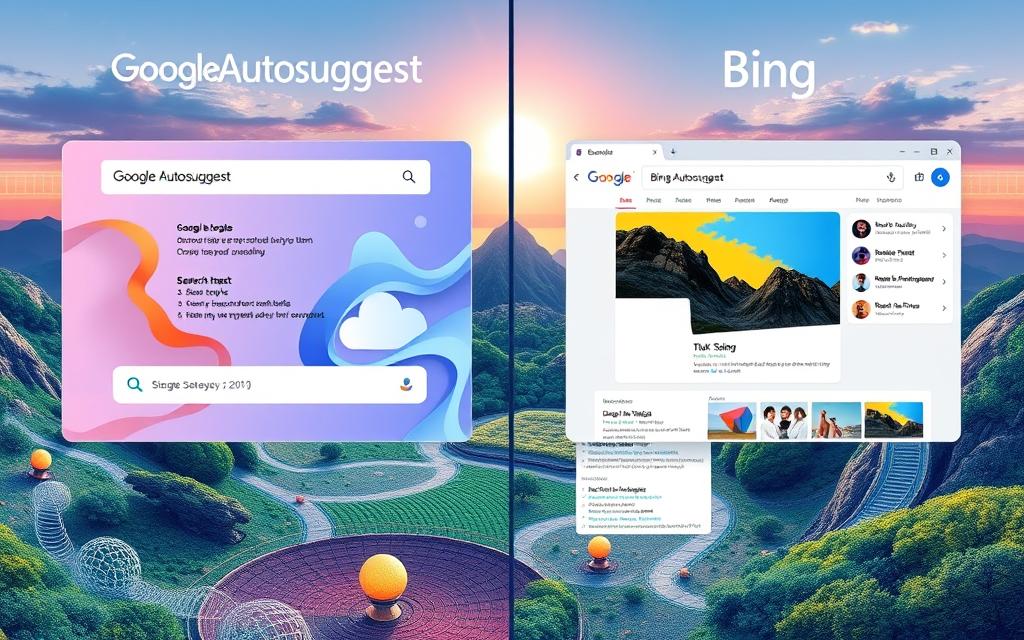Have you ever noticed how Google and Bing can guess your search as you type? This is called “autosuggest” or “autocomplete.” It makes searching online easier and more personal. But, you can also shape these suggestions to help you.
Google’s autosuggest guesses your search based on what others have searched for. It looks at language, location, trends, and your past searches. Bing’s autocomplete works similarly, using real-time data and web patterns. Both search engines block harmful or policy-breaking suggestions.
Using autosuggest wisely can change your online game. It can boost your visibility and SEO. Reputation Return can help you tweak your autosuggest results on Google and Bing.
This guide will dive into Google and Bing’s autosuggest. We’ll show you how to use them to your advantage. Reputation Return will be your ally in this journey. Whether you’re an individual or a business, autosuggest is a key digital marketing tool.
Key Takeaways
- Google and Bing’s autosuggest features are based on real user searches and web-based patterns
- Both search engines have systems in place to prevent inappropriate or harmful predictions
- Leveraging autosuggest can significantly improve your online visibility and reputation
- Reputation Return offers expert services to modify and enhance your autosuggest results
- Understanding and strategically influencing autosuggest can be a game-changer for your digital marketing efforts
Understanding Google Autosuggest
What is Google Autosuggest?
Google Autosuggest is a tool that makes searching faster. It shows likely search terms based on what you’ve typed so far. These suggestions come from real Google searches, your location, and past searches.
How Does Google Autosuggest Work?
Autocomplete shows common search terms, but it’s not just about the most searched ones. Google uses many signals to pick the best suggestions for you. As you type more, the suggestions change to help you find what you’re looking for.
Google’s Autocomplete aims to keep out harmful or offensive suggestions. It has strict rules to block such content. Automated systems and teams enforce these rules.
Autocomplete suggestions don’t change your search results. They only help with the suggestions. Sometimes, Google might block useful suggestions to stay safe. The algorithm considers many things, like search volume and web content.
Google says Autosuggest saves over 200 years of typing every day. It cuts down typing by about 25% on average.

Bing Autocomplete vs Google Autocomplete
Both Bing Autocomplete and Google Autosuggest help users find what they’re looking for faster. But, there are some key differences that marketers should know.
Bing’s Autocomplete uses trending searches and popular queries to suggest answers. Google’s Autosuggest, on the other hand, looks at your location and search history for a more personal touch.
Google Autosuggest is better at keeping out bad or policy-breaking suggestions. This makes for a cleaner and safer search experience. It’s great for businesses wanting to keep a good online image.
Even with their differences, both bing autocomplete and how does bing autosuggest work? are useful for SEO and content planning. Knowing their strengths can help marketers use these tools better.
| Feature | Bing Autocomplete | Google Autosuggest |
|---|---|---|
| Algorithm Focus | Trending searches, popular queries | User location, search history, personalized results |
| Prediction Quality | Offers unique, less-traveled search paths | Widely recognized for accuracy and relevance |
| Policy Enforcement | Less robust systems for preventing inappropriate suggestions | Stronger mechanisms to block unsuitable predictions |
Understanding the bing autocomplete vs google autocomplete differences helps marketers. They can use these tools to improve their online presence and attract more relevant visitors.

The Power of Google Autosuggest for SEO
Google’s Autosuggest feature is a big help for SEO. It shows what people are likely to search for. This helps you make your content better and find new keywords to use.
Keyword Research with Google Autosuggest
Google Autosuggest is great for finding keywords. It shows you what people type when they start searching. This helps you find long-tail keywords that are less competitive but still important.
Long-Tail Keyword Opportunities
Long-tail keywords from Google Autosuggest are very useful. They show what users really want to find. By using these keywords, you can make your content more relevant and attract more visitors. Using Google Autosuggest for SEO can really boost your online presence.

| Keyword | Monthly Search Volume | Keyword Difficulty |
|---|---|---|
| google autosuggest for seo | 1,900 | 45 |
| keyword research with google autosuggest | 1,300 | 40 |
| google autosuggest long-tail keywords | 720 | 35 |
How to Influence Google Autocomplete Results
Creating Content for Google Autosuggest
Google Autocomplete results are shaped by algorithms and real user searches. Yet, you can influence them a bit. A key strategy is to create content that matches the types of queries in Autosuggest. By making relevant, high-quality content, you can boost your chances of showing up in Autocomplete.
To use Google Autosuggest for SEO, follow these tips:
- Identify Relevant Autocomplete Suggestions – Use tools like Google Keyword Planner and Google Trends to find common and relevant suggestions in your field.
- Optimize Content for Long-Tail Keywords – Add long-tail keywords from Autosuggest to your content to increase visibility and attract better traffic.
- Create Genuinely Useful Content – Make sure your content offers real value and meets the search intent behind Autocomplete suggestions. Stay away from tactics that break Google’s rules.
- Monitor and Adjust – Keep an eye on how your content does in Autocomplete and update it to stay relevant and visible.
Even though Google has strict rules for Autocomplete, following best practices and making useful content can help you succeed with SEO.

Google Autosuggest Keyword Research Tools
Using Google Autosuggest for keyword research can change the game for your content and SEO. There are many tools and methods to help you make the most of it. You can use browser extensions or standalone tools to analyze the data.
Browser extensions or plugins can capture and export search predictions as you type. They give you insights into what users are searching for. This helps you find long-tail keywords and improve your targeting.
Google autosuggest keyword research tools are another option. These tools can gather Autosuggest data in bulk. They provide detailed reports to help you optimize your content and SEO.
You can also monitor Autosuggest results in real-time and analyze search query data. Combining Autosuggest insights with other methods can give you a wealth of information. This helps you create content that really connects with your audience.
It’s important to try different tools and strategies to find what works best for your business. With the right tools, you can discover a lot of valuable keyword insights. This can take your content and SEO to new levels.

Bing Autosuggest: How Does It Work?
While Google Autosuggest is well-known, Bing’s Autocomplete works similarly. It gives users search suggestions to help them finish their queries. But, the Bing Autocomplete algorithm works differently from Google’s.
Understanding Bing’s Autocomplete Algorithm
Bing focuses more on trending search data and popular queries. It doesn’t use as many signals as Google, like user location and search history. This means Bing’s suggestions might show broader market trends, not just what you’re likely to search for.
For instance, Bing might suggest more general, high-volume keywords than Google. Google often suggests based on what you’ve searched before. Knowing these differences helps marketers plan better for both Google and Bing.
Bing’s Autocomplete API gives about 10 suggestions per request, like Google. But, adding a character after a keyword can increase results to around 350 per keyword.
| Search Engine | Autocomplete Suggestions per Request | Autocomplete Suggestions with Character Appended |
|---|---|---|
| Approximately 10 | Approximately 350 | |
| Bing | Approximately 10 | Approximately 350 |
| Amazon | Approximately 10 | Approximately 350 |
Knowing how the Bing Autocomplete algorithm works can improve your search marketing for Bing. It helps make sure your content is found and liked by users.
Optimizing for Bing Autosuggest
While many focus on Google Autosuggest, optimizing for Bing’s Autocomplete feature can also be beneficial. Bing’s algorithm values trending data and popular searches more. So, creating content that matches these trends is key.
Start by researching what people are searching for in Bing Autocomplete. Then, make content that answers those questions well. Also, use long-tail keywords from Bing Autocomplete to boost your content’s visibility and attract more relevant traffic.
By using a smart, data-driven approach to bing autosuggest seo strategy, you can reach more people. Here are some tips for how to optimize for bing autosuggest:
- Research popular Bing Autocomplete queries in your industry
- Create content that directly addresses those search queries
- Incorporate relevant long-tail bing autocomplete optimization keywords into your content
- Optimize on-page elements like titles, descriptions, and headers for Bing
- Monitor Bing search trends and adapt your content strategy accordingly
By focusing on Bing Autosuggest optimization, you can attract more visitors. This is especially true for businesses looking to grow their online presence.
Google Autocomplete Policies and Restrictions
Google’s Autocomplete feature helps users find relevant search suggestions as they type. To keep the experience safe and helpful, Google has strict rules for Autocomplete.
Inappropriate Predictions and Removals
Google won’t suggest things that are sexually explicit, hateful, violent, or otherwise inappropriate. If a suggestion breaks these rules, Google quickly removes it and similar suggestions.
Users can also report inappropriate predictions through feedback mechanisms. Even with strict rules, some bad content might get through. Google works hard to balance the usefulness of Autocomplete with keeping it safe.
Some important facts about Google Autocomplete policies and restrictions:
- The Place Autocomplete service can match on full words and substrings, resolving place names, addresses, and plus codes.
- The Place Autocomplete service restricts results to a specified circular area with a radius of up to 50,000 meters for different types of searches.
- The language parameter specifies the language in which to return results and should be chosen from the supported languages list, which is periodically updated by Google.
- A Place Autocomplete request must include an input parameter that specifies the text string on which to search and order results based on relevance.
- The region parameter requires a ccTLD two-character value, which is usually identical to ISO 3166-1 codes, except for some exceptions like the United Kingdom.
By following Google’s Autocomplete rules, everyone can use this feature wisely. This ensures a good and safe experience for all users.
Google autosuggest
Google Autosuggest helps users find what they’re looking for faster. It’s also great for marketers and content creators. They can use it to make content that people will really enjoy.
By looking at what people search for, businesses can learn a lot. They can find out what their audience wants to know. This helps them make better content, like blog posts and videos.
They can also find new keywords to use. These keywords might not be as popular, but they can still attract a lot of people.
Tapping into the Power of Google Autosuggest
Using Google Autosuggest can make your content better. Here’s how:
- Identify Popular Topics and Trends: See what people are searching for most. This tells you what they care about.
- Discover Long-Tail Keyword Opportunities: Find special keywords that not many people use. These can be good for your content.
- Understand User Intent: Look at what people are searching for. This helps you know what they need help with.
By using Google Autosuggest for content ideas and Google Autosuggest for content strategy, you can make content that really speaks to your audience. It will be more engaging and relevant to their needs.
Removing Unwanted Google Autocomplete Suggestions
Google’s Autocomplete feature can be both helpful and unwanted. It often gives good search suggestions but sometimes includes things you don’t want to see. Luckily, Google lets you ask to remove certain suggestions that break their rules.
To remove unwanted Google Autocomplete suggestions, you can use Google’s feedback tools. Report any suggestions with hate speech, violence, or explicit content. Google’s teams will check it and remove it if it breaks their rules.
Google has strict rules to avoid misuse of the system. But, by using the right reporting channels, you can reduce the harm of unwanted suggestions. This helps protect your online image and reputation.
- Identify the unwanted Autocomplete suggestion
- Use Google’s feedback tools to report the violation
- Wait for Google’s review and potential removal of the suggestion
- Monitor the changes and continue to report any new unwanted predictions
The process of changing Google autosuggest can take a few months. Google looks at search activity and updates its suggestions. By taking the right steps and keeping your search activity positive, you can manage and remove unwanted suggestions.
The Impact of Reputation on Autosuggest Results
Your online reputation greatly affects what shows up in autosuggest when people search for you. If your business or personal brand has negative content online, it might appear in autosuggest. This can harm your visibility and credibility. That’s where Reputation Return comes in.
How Reputation Return Can Help
Reputation Return keeps an eye on autosuggest results and tries to remove unwanted ones. They use content optimization, legal requests, and other strategies to help you manage your online image. This way, the suggestions that show up better match your brand and message.
For instance, Chipotle gets 4 million searches every month. But, “human feces” was a common search term related to the brand. Such negative suggestions can scare off customers and investors. Reputation Return helps protect your reputation from such issues.
| Reputation Impact | Reputation Return Solution |
|---|---|
| Negative autosuggest predictions like “human feces” for Chipotle | Proactive monitoring and suppression of unwanted autosuggest results |
| Discriminatory keywords like “gay” or “transgender” appearing in autosuggest | Content optimization and legal takedown requests to remove inappropriate suggestions |
| Reputational risks due to virality and user behavior influencing autosuggest | Comprehensive reputation management strategies to control your online narrative |
With Reputation Return, you can manage your autosuggest results better. This ensures the suggestions match your brand’s identity and message. It’s a key part of keeping your online reputation strong.
Best Practices for Leveraging Autosuggest
Balancing User Intent and SEO
To get the most out of Google and Bing Autosuggest, follow some key steps. First, make sure your content meets the search queries and needs shown in Autosuggest. This way, you avoid just trying to boost your SEO.
Creating content that truly helps users is crucial. This approach makes your brand more likely to show up in Autosuggest. It also brings in more relevant visitors.
But, don’t forget to use Autosuggest keywords in your content. This can help you get seen more and rank higher. The goal is to find a balance that meets both user needs and SEO goals.
Using Autosuggest well can greatly help your digital marketing. For example, you can use SEO techniques to improve your online presence and manage your reputation.
Your success with Autosuggest depends on creating content that speaks to your audience and meets your SEO goals. Stay in touch with what users want and search for. This way, you can attract more relevant traffic, better customer experiences, and boost your digital marketing success.

